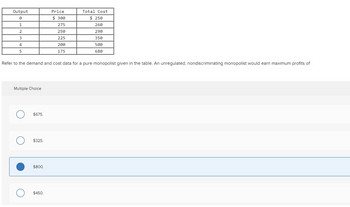
ENGR.ECONOMIC ANALYSIS
14th Edition
ISBN: 9780190931919
Author: NEWNAN
Publisher: Oxford University Press
expand_more
expand_more
format_list_bulleted
Question

Transcribed Image Text:Output
1
2
3
4
5
Multiple Choice
Refer to the demand and cost data for a pure monopolist given in the table. An unregulated, nondiscriminating monopolist would earn maximum profits of
O $675.
O $325.
$800.
Price
$ 300
275
250
225
200
175
O $450.
Total Cost
$ 250
260
290
350
500
680
Expert Solution
This question has been solved!
Explore an expertly crafted, step-by-step solution for a thorough understanding of key concepts.
This is a popular solution
Trending nowThis is a popular solution!
Step by stepSolved in 3 steps

Knowledge Booster
Learn more about
Need a deep-dive on the concept behind this application? Look no further. Learn more about this topic, economics and related others by exploring similar questions and additional content below.Similar questions
- 3. Use the diagram to show that a price discriminating monopolist earns more profit than one charging a single price. Show further that he enjoys a greater profit the more he can discriminate (that is, the more different prices he can charge). Р 90 80 70 50 40 30 20 10 MC MR 1 2 3 4 5 6 7 8 9 Qarrow_forwardThe table below shows a portion of the demand schedule faced by a monopoly firm. Based on the table, the marginal revenue of the third unit of output equals Table 8-3 Price $12 $11 $10 $9 a. $1 b. $10 c. $8 d. $12 O e. $6 00000 Quantity 1 2 3 4arrow_forwards Assume that a monopolist is able to engage in perfect price discrimination and sell each unit of the product at a price equal to the maximum price the buyer of that unit of the product would be willing to pay. Complete the table below by computing total revenue and marginal revenue for the price discriminating monopolist. Quantity Price Total revenue Marginal revenue Total Cost Marginal cost 0 $34 $ 1 32 30 28 26 24 22 20 18 16 14 234SSN 5 6 7 89 10 $ $20 36 46 50 54 56 64 80 100 128 160 $ (a) What is the marginal revenue that the discriminating monopost obtains from the sale of each additional unit? (b) How many units would be produced and what would be the total revenue for the perfectly discriminating monopolist? What would economic profits be? (c) Compare the economic effects of price discrimination to no price discrimination for the pure monopolist in terms of profits and the level of output.arrow_forward
- Question 16 Monopolistic Competition -- Questions 16-20 refer to Figure 6-2 below. This figure depicts a situation in a monopolistically competitive market. Figure 6-2 105 100- MC 95 90+ ATC 70 65 60 55 30 45 40 35 30 25 20 15 10+ MR Demand +++ s 10 is 20 25 30 35 40 4s s0 ss 60 6s 70 7s so as 90 95 10010s1101is120 Refer to Figure 6-2. What quantity will the monopolistically competitive firm charge in this market?arrow_forwarddo fastarrow_forward3 4 5 6 The profit maximizing monopolist would choose to produce 30 28 26 24 32 Price 38 36 34 + V Output 36 32 28 24 Marginal Revenue 20 16 12 26 27 28 29 30 31 32 33 Marginal Cost units of outputarrow_forward
- Exhibit 10-4 $/0 MC ATC 24 /t 10 The non-discriminating monopolist in Exhibit 10-4 should: O Produce 10 units at a price of $36 per unit. O Produce 10 units at a price of $24 per unit. O Produce 10 units at a price of $40 per unit. O Produce 15 units at a price of $32 per unit. O We cannot determine what the firm should do without knowing its average variable cost.arrow_forwardpart 10 11 needed.......arrow_forwardNonearrow_forward
- Ñ6arrow_forward5 int ences $55 $50 $45 $40 $35 $30 $25 $20 $15 $10 $5 0 N MR units MC Quantity D 4 5 6 7 8 9 10 11 Tools DWL Instructions: In parts a and b, enter your answers as a whole number. In parts c-e, round your answers to two decimal places. a. What is the profit-maximizing level of output? b. What price will the monopolist charge to maximize profits? $ CS c. Determine the efficiency costs (deadweight loss) of monopoly output/pricing. Instructions: Use the tool provided 'DWL' to illustrate this area on the graph. Drag the points to move or resize. What is the efficiency cost (deadweight loss) of monopoly output/pricing? d. Determine the consumer surplus under monopoly output/pricing. Help Save & Exit Submitarrow_forwardAsap please .. i vll give positive feedback and definitely upvote as well .... Asap plzarrow_forward
arrow_back_ios
SEE MORE QUESTIONS
arrow_forward_ios
Recommended textbooks for you

 Principles of Economics (12th Edition)EconomicsISBN:9780134078779Author:Karl E. Case, Ray C. Fair, Sharon E. OsterPublisher:PEARSON
Principles of Economics (12th Edition)EconomicsISBN:9780134078779Author:Karl E. Case, Ray C. Fair, Sharon E. OsterPublisher:PEARSON Engineering Economy (17th Edition)EconomicsISBN:9780134870069Author:William G. Sullivan, Elin M. Wicks, C. Patrick KoellingPublisher:PEARSON
Engineering Economy (17th Edition)EconomicsISBN:9780134870069Author:William G. Sullivan, Elin M. Wicks, C. Patrick KoellingPublisher:PEARSON Principles of Economics (MindTap Course List)EconomicsISBN:9781305585126Author:N. Gregory MankiwPublisher:Cengage Learning
Principles of Economics (MindTap Course List)EconomicsISBN:9781305585126Author:N. Gregory MankiwPublisher:Cengage Learning Managerial Economics: A Problem Solving ApproachEconomicsISBN:9781337106665Author:Luke M. Froeb, Brian T. McCann, Michael R. Ward, Mike ShorPublisher:Cengage Learning
Managerial Economics: A Problem Solving ApproachEconomicsISBN:9781337106665Author:Luke M. Froeb, Brian T. McCann, Michael R. Ward, Mike ShorPublisher:Cengage Learning Managerial Economics & Business Strategy (Mcgraw-...EconomicsISBN:9781259290619Author:Michael Baye, Jeff PrincePublisher:McGraw-Hill Education
Managerial Economics & Business Strategy (Mcgraw-...EconomicsISBN:9781259290619Author:Michael Baye, Jeff PrincePublisher:McGraw-Hill Education


Principles of Economics (12th Edition)
Economics
ISBN:9780134078779
Author:Karl E. Case, Ray C. Fair, Sharon E. Oster
Publisher:PEARSON

Engineering Economy (17th Edition)
Economics
ISBN:9780134870069
Author:William G. Sullivan, Elin M. Wicks, C. Patrick Koelling
Publisher:PEARSON

Principles of Economics (MindTap Course List)
Economics
ISBN:9781305585126
Author:N. Gregory Mankiw
Publisher:Cengage Learning

Managerial Economics: A Problem Solving Approach
Economics
ISBN:9781337106665
Author:Luke M. Froeb, Brian T. McCann, Michael R. Ward, Mike Shor
Publisher:Cengage Learning

Managerial Economics & Business Strategy (Mcgraw-...
Economics
ISBN:9781259290619
Author:Michael Baye, Jeff Prince
Publisher:McGraw-Hill Education